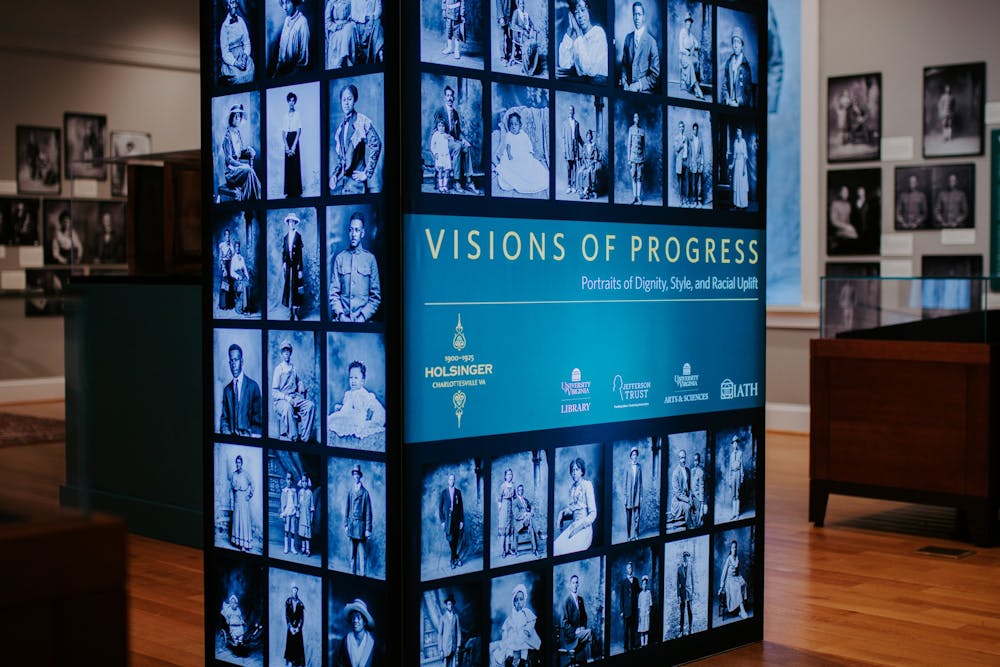Close to 200 faces of Black Virginians now line the walls of the Albert and Shirley Small Special Collections Library, offering visitors a personal glimpse at life during the peak of the Jim Crow era. On display from now through June of next year, the exhibit features portraits taken in the Holsinger Studio in an effort to redefine perspectives on Black history.
What is most striking about each black-and-white portrait is the simple humanity displayed in each one, says John Edwin Mason, chief curator of the exhibit and history professor. While the images depict people from a variety of occupations — from janitor to farm laborer to waiter — the portraits gave Black community members the chance to define how they wanted to present themselves to the camera.
“That’s the point — they weren’t defined by their jobs,” Mason said. “They weren’t defined by Jim Crow.”
In the early 20th century during the height of the Jim Crow era — a period marked by the legalization of discriminatory and racist practices — Charlottesville was dominated by racial segregation and white supremacy, with an active Ku Klux Klan presence and entrenched eugenic practices.
Rufus Holsinger established his studio in Charlottesville in the late 1880s, where Mel’s Cafe is now located on West Main St. After Rufus’ death in 1930, his son Ralph Holsinger took over the business, and operated the studio until he retired in 1969, and the studio closed in 1977.
The Holsinger Studio Collection in Special Collections includes an estimated 10,000 wet-plate glass negatives, of which about two-thirds are portraits. For Black residents, portraits were a rare opportunity, and cost up to $20 in today’s dollars. More than 500 portraits were commissioned by Black residents of Central Virginia, many of whom were employed by the University.
“We were all interested in more than just the fact that they are beautiful and seeing them as aesthetic objects,” Mason said. “We wanted to see them as historical objects and to see history through them. We’re blending aesthetics with the ability to see history in these images.”
Mason stumbled upon the Holsinger collection in 2014, and was immediately fascinated by them. He knew he wanted to bring them into a larger space — alongside the physical exhibit is a website with biographical information about many of the portrait subjects, meticulously researched by students and researchers at the Institute for Advanced Technology in the Humanities.
While researchers have aimed to magnify the stories behind the subjects, the photographs themselves are enhanced, too — each has been digitized using modern technology and was given individual attention by skilled photographers. Holly Robertson, curator of University Library Exhibitions and one of the curators for the exhibit, said that the digitization efforts were one of the most exciting aspects of the exhibit.
“That was a really special additive for the exhibition — that we were able to get not just the images we’ve always had, but to have such expert eyes [to] bring these images to true life,” Robertson said.
In 1912, the Holsinger Studio suffered a studio fire that destroyed business ledgers and some of the negatives, making it difficult to identify portraits. In preparation for the exhibit, the Holsinger studio hosted Family Photo Day March 9, where individuals from Charlottesville and the greater Albemarle area were invited to identify family members in the photographs. Attendees could also share their own oral histories or get portraits taken at no cost.
The exhibit, Robertson said, is unique because of these ties to the Charlottesville and Albemarle community.
“We’re focusing on such a local … community of people who have great-grandparents and great-aunts,” Robertson said. “We learn a new story every day of someone who sees someone they recognize from their family.”
Mason hopes that the exhibit will encourage attendees to see Black history in a new way — both literally through the photographs, and in a broader sense. A lot of this, Mason said, comes from focusing on the human experience of the subjects of the portraits, and providing a glimpse into their everyday lives.
“We’ve been spending a lot of time think about the role of slavery in shaping this country, the role of white supremacy in shaping this country, and that’s really important,” Mason said. “But what we haven’t spent very much time doing is thinking about what Black peoples were doing, despite all the obstacles.”
Funding for the exhibit came from the Special Collections Library and the Institute for Advanced Technology in the Humanities. The Jefferson Trust also provided a $73,000 grant, which is largely being used to support this project.
Mason said the Holsinger Portrait Project has plans to expand community outreach, including traveling exhibitions that go to schools, religious institutions and community centers.
“Using those life stories then to speak about a much larger history — local, national, international history — that can be a resource for years to come,” Mason said.







